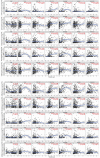Identification by Bioinformatics Analysis of Potential Key Genes Related to the Progression and Prognosis of Gastric Cancer
- PMID: 35600357
- PMCID: PMC9114743
- DOI: 10.3389/fonc.2022.881015
Identification by Bioinformatics Analysis of Potential Key Genes Related to the Progression and Prognosis of Gastric Cancer
Abstract
Objective: Despite increasingly sophisticated medical technology, the prognosis of patients with advanced gastric cancer is still not objectively certain. Therefore, it is urgent to identify new diagnostic and prognostic biomarkers. To identify potential critical genes related to gastric cancer's staging mechanism and to the prognosis of gastric cancer.
Methods: Dynamic trend analysis was conducted to find genes with similar trends in gastric cancer staging in order to explore the differentially expressed genes in gastric cancer and identify the intersection of the results of the dynamic trend analysis. Functional predictive analysis were performed on the obtained genes to observe the expression of prognostic genes in gastric cancer and in gastric cancer stages as well as the correlation with tumor immune cell infiltration. Gastric cancer samples were collected and sequenced for follow-up analysis based on the results of the Cancer Genome Atlas (TCGA) database analysis.
Results: The expression of genes enriched in module 0 had a similar trend in gastric cancer staging. 3213 differential genes were screened. A total of 50 intersection genes were obtained among genes with similar trends, of which only 10 genes have prognostic significance in gastric cancer. These 10 genes were correlated with macrophage infiltration in varying degrees. In addition, we found that AGT was significantly abnormally expressed in the results of sample sequencing. AGT was related to the occurrence of gastric cancer and interacted with brd9, golph3, nom1, klhl25, and psmd11.
Conclusion: AGT has prominent abnormal expression in gastric cancer and may promote gastric cancer progression. This study provides a new direction for further exploring potential biomarkers and molecular targeted gastric cancer therapy.
Keywords: RNA-seq; TNM stage; bioinformatics analysis; gastric cancer; tumor immune cell infiltration.
Copyright © 2022 Gao and Yang.
Conflict of interest statement
The authors declare that the research was conducted in the absence of any commercial or financial relationships that could be construed as a potential conflict of interest.
Figures








References
LinkOut - more resources
Full Text Sources
Miscellaneous

